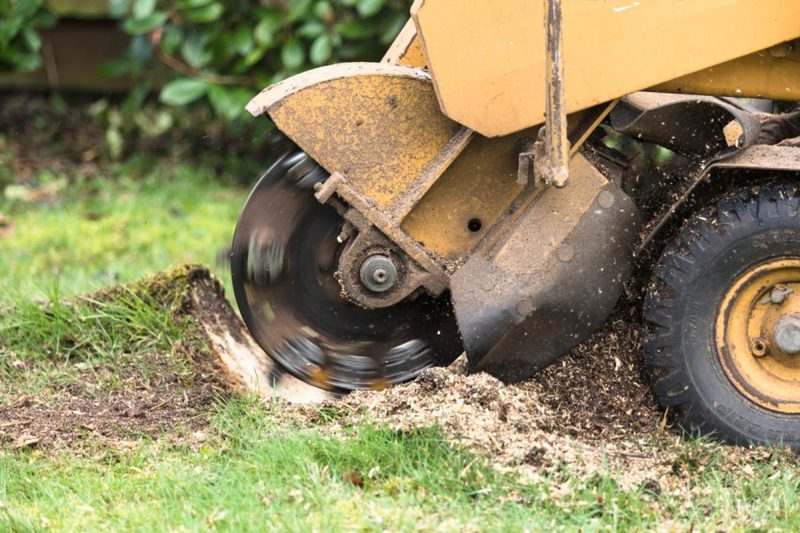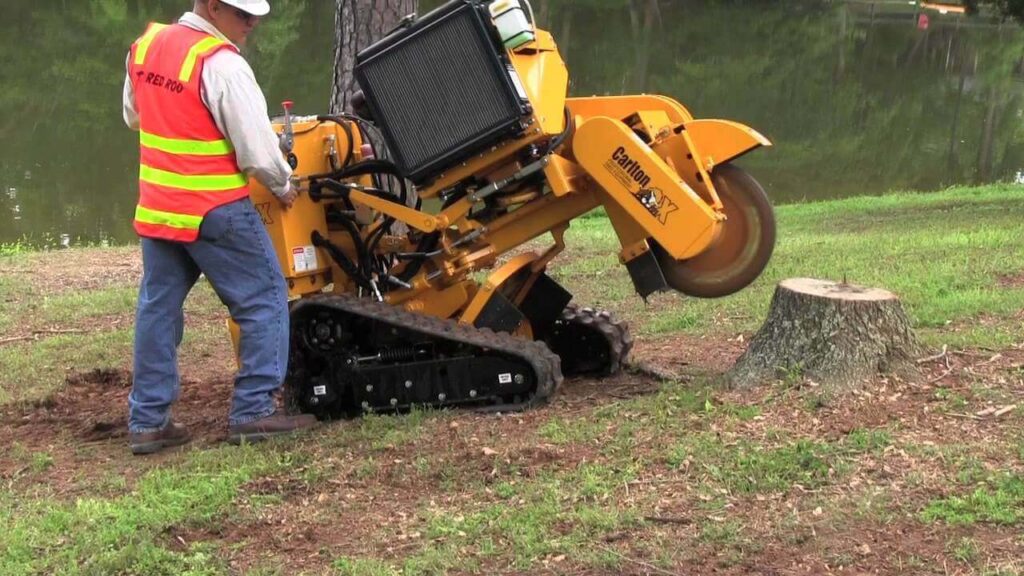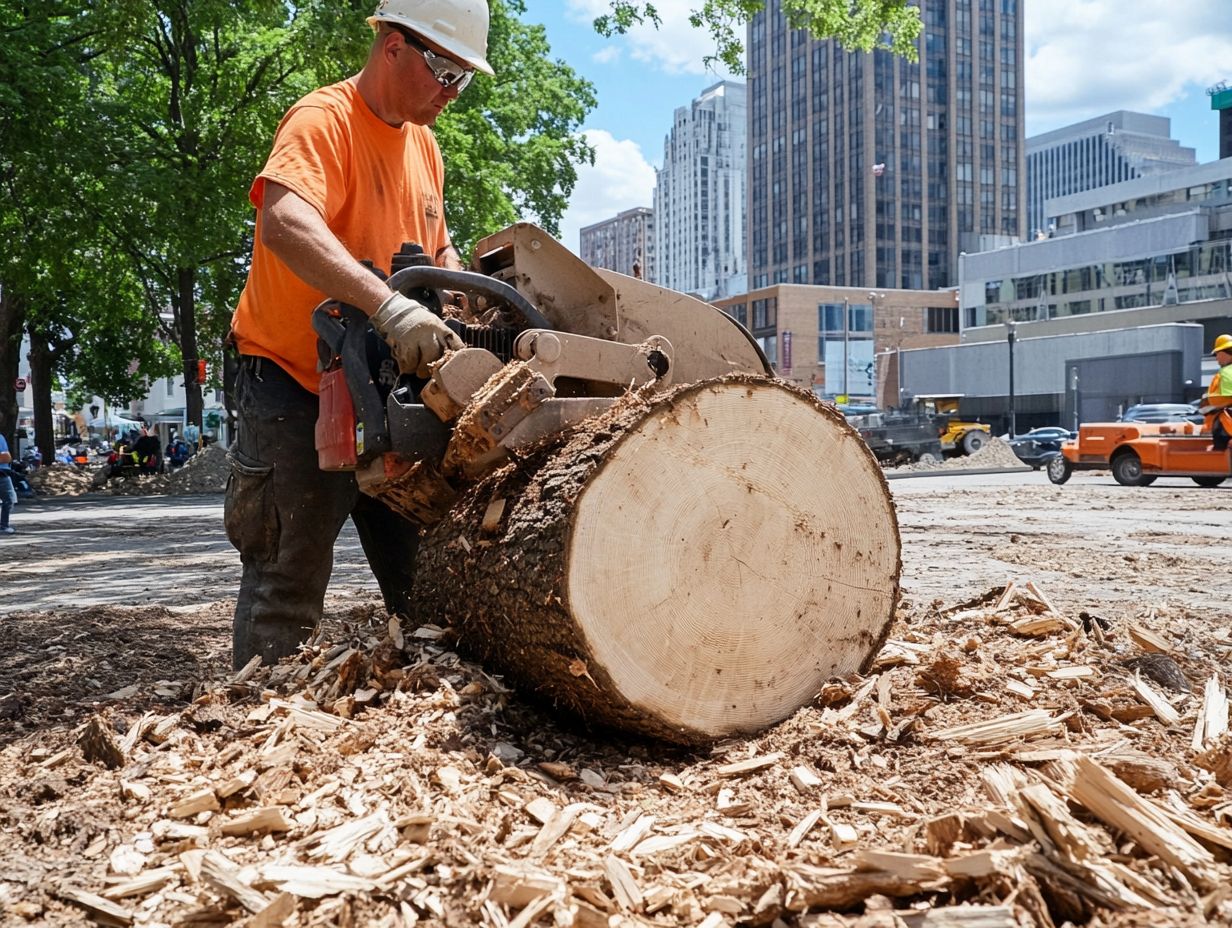What Is Stump Grinding and How Does It Impact The Environment?
Stump grinding is a mechanical tree removal method that uses specialised equipment to chip away tree stumps below ground level, reducing them to wood chips and sawdust. This process effectively eliminates visible remnants of felled trees, allowing property owners to reclaim land for landscaping, construction, or other purposes.
The environmental impact of stump grinding extends beyond the immediate removal site. When stumps are ground down, several ecological consequences emerge:
1. Habitat Destruction
- Tree stumps serve as microhabitats for insects, fungi, and small mammals, but before removing them, it’s important to consider the stump grinding cost and the potential impact on local ecosystems.
- Removal disrupts established food chains and shelter systems
- Native species lose crucial breeding and nesting sites

2. Soil and Ecosystem Disruption
- Grinding disturbs soil structure and beneficial microorganisms
- Root systems that stabilize soil and prevent erosion are destroyed
- Nutrient cycling processes are interrupted when decomposing wood is removed
3. Biodiversity Loss
The removal of stumps eliminates dead wood, which supports up to 40% of woodland biodiversity. Beetles, woodpeckers, and fungi that depend on decaying timber lose essential resources. This cascading effect reduces species diversity across entire ecosystems.
Understanding why stump grinding pricing should include environmental offsets begins with recognising these hidden ecological costs. Each stump removed represents a small but significant loss to local biodiversity that requires compensation through targeted conservation actions.
What Are Environmental Offsets and Why Should They Be Included In Stump Grinding Pricing?
Environmental offsets are conservation actions designed to compensate for unavoidable damage to native vegetation and wildlife habitats. These measures work by protecting, restoring, or enhancing equivalent ecological areas elsewhere, ensuring no net loss of biodiversity occurs when trees and stumps are removed from a site.
The environmental offsets definition centres on achieving ecological balance. When a stump grinding service removes vegetation, it eliminates microhabitats that support fungi, insects, small mammals, and decomposer organisms. Offsets counteract this loss by funding habitat creation or restoration projects in other locations, maintaining the region’s overall biodiversity value.
Stump grinding pricing justification becomes clearer when considering the true ecological footprint of the service. Traditional pricing models only account for labour, equipment, and disposal costs. They ignore the environmental debt created when removing stumps that would naturally decompose over decades, providing essential nutrients and shelter to countless species.
Including offsets in pricing structures achieves several goals:
- Reflects the genuine environmental cost of vegetation removal
- Funds tangible conservation projects that benefit displaced wildlife
- Encourages property owners to consider ecological impacts before removing stumps
- Supports sustainable land management practices across communities
This pricing approach transforms stump grinding from a purely extractive service into one that acknowledges and addresses its ecological consequences. Property owners pay for both the physical removal and the environmental restoration needed to balance that removal.
How Do Environmental Offsets Benefit Biodiversity And Ecosystem Health?
Environmental offsets create measurable improvements in biodiversity enhancement by establishing protected habitats where native species can thrive and reproduce. When stump grinding projects fund offset initiatives, these conservation actions directly increase the number and variety of species in restored areas, from ground-dwelling insects to canopy-nesting birds.
Habitat improvement through offsets delivers multiple ecological advantages:
- Creation of interconnected wildlife corridors that allow species to move safely between fragmented habitats
- Restoration of native vegetation that provides food sources and shelter for displaced animals
- Enhancement of soil quality and water retention in degraded landscapes
- Protection of threatened species through targeted habitat rehabilitation
Ecosystem resilience strengthens significantly when offset programmes restore natural processes. For instance, forest thinning as part of an offset strategy can help restore habitats, allowing them to develop greater capacity to withstand environmental stresses like drought, disease, and climate fluctuations. Native plant communities established through offset funding create self-sustaining ecosystems that require minimal intervention over time.
Human communities gain substantial advantages from these ecological improvements. Enhanced green spaces improve air quality, reduce urban heat, and provide recreational opportunities for residents. Healthy ecosystems also deliver essential services like pollination, pest control, and water filtration that support agricultural productivity and public health.
The compounding effect of well-designed offsets means that initial investments in habitat restoration generate increasing returns as ecosystems mature and species populations stabilise.
What Types Of Conservation Actions Are Funded By Environmental Offsets In The Context Of Stump Grinding?
Environmental offsets from stump grinding pricing directly fund habitat restoration projects that recreate or enhance natural environments for displaced wildlife. These conservation actions transform degraded land into thriving ecosystems that support native species affected by tree and stump removal.
1. Woodland expansion programmes
Woodland expansion programmes receive funding to establish new forest areas that provide shelter, food sources, and breeding grounds for birds, mammals, and insects. These projects often focus on planting native tree species that match the ecological characteristics of the removed vegetation, ensuring continuity for local wildlife populations.
2. Wildlife corridors
Wildlife corridors represent another critical stump grinding conservation action, connecting fragmented habitats to allow safe movement of species between areas. These green pathways enable animals like gliders, possums, and ground-dwelling mammals to access food, mates, and new territories without crossing dangerous open spaces.
Offset funding also supports:
- Wetland restoration for amphibians and waterbirds
- Hollow-bearing tree installation for cavity-nesting species
- Invasive species removal to improve habitat quality
- Nest box programmes for displaced wildlife
- Threatened species recovery initiatives targeting koalas, powerful owls, and native frogs
Why stump grinding pricing should include environmental offsets becomes clear when examining these tangible conservation outcomes. Each funded project directly addresses the ecological debt created by vegetation removal, ensuring native species retain viable habitats despite land clearing activities.
How Can Including Environmental Offsets In Stump Grinding Pricing Promote Sustainable Land Management Practices?
Environmental offsets transform stump grinding from a simple removal service into an active participant in sustainable land use strategies. By embedding offset costs into pricing structures, property owners and land managers must account for the full environmental footprint of their decisions before proceeding with tree removal.
This pricing model creates a direct financial link between land clearing activities and conservation outcomes. When stakeholders see the true cost of vegetation removal reflected in their invoices, they’re more likely to:
- Evaluate whether stump removal is genuinely necessary
- Consider alternative land management approaches
- Plan vegetation clearing with ecological responsibility at the forefront
- Prioritise retention of existing trees and stumps where feasible
The offset mechanism encourages long-term thinking about land stewardship. Property developers, councils, and private landowners begin viewing their sites as interconnected parts of larger ecosystems rather than isolated parcels. This shift in perspective drives more thoughtful decision-making around vegetation management.
Integrating offsets into stump grinding costs also establishes a precedent for other land management services. When tree removal companies adopt this pricing approach, they demonstrate that environmental accountability can coexist with commercial operations. This sets industry standards that recognise nature’s value whilst maintaining viable business models that support both economic activity and ecological preservation.
What Are The Broader Implications For Society As A Whole When It Comes To Integrating Environmental Costs Into Stump Grinding Pricing?
Integrating environmental costs into stump grinding pricing creates a ripple effect that extends far beyond individual properties. This approach establishes a precedent for conservation funding mechanisms across all land management sectors, demonstrating that ecological responsibility can be built directly into service delivery models.
The societal benefits manifest in multiple dimensions. When stump grinding services include offset costs, communities gain access to enhanced green spaces, improved air quality, and strengthened ecosystem services like water filtration and carbon sequestration. These environmental improvements translate into tangible health benefits, reducing respiratory illnesses and providing recreational opportunities that enhance mental wellbeing.
Future generations inherit landscapes shaped by today’s pricing decisions. Including environmental offsets ensures that current tree removal activities don’t create ecological debts for tomorrow’s communities to repay. Children growing up in areas where offset-funded conservation projects thrive experience richer biodiversity, fostering environmental awareness and stewardship values.
The economic implications deserve attention as well. Regions that adopt comprehensive environmental accounting in service pricing often attract environmentally conscious businesses and residents, boosting property values and creating green job opportunities in habitat restoration and ecological monitoring. This pricing model shifts the paradigm from viewing environmental protection as a regulatory burden to recognising it as an investment in community resilience and long-term prosperity.

Conclusion
Why should stump grinding pricing include environmental offsets? The answer lies in recognising that every tree removal carries an ecological debt that demands repayment through meaningful conservation action.
Stump grinding sustainability depends on transparent environmental cost inclusion that reflects the true impact of vegetation removal. When property owners and land managers choose services that incorporate offset funding, they actively participate in protecting biodiversity and restoring habitats for displaced wildlife.
The path forwards requires collective commitment. Support tree service providers who embrace this pricing model, advocate for policies that mandate environmental offsets, and educate others about the connection between land management decisions and ecosystem health. Your choice to prioritise services with built-in conservation measures creates tangible change—protecting native species, strengthening habitat corridors, and ensuring future generations inherit thriving natural landscapes rather than depleted ones.
Take action today by requesting offset-inclusive quotes from your local stump grinding providers.
Learn about: What Stump Grinding in Sydney Teaches Us About Endings and Regrowth
FAQs
Stump grinding is a mechanical tree removal method that uses specialized equipment to chip away tree stumps below ground level, reducing them to wood chips and sawdust, allowing property owners to reclaim land.
Stump grinding can disrupt habitats, destroy soil structure, eliminate deadwood that supports biodiversity, and interrupt nutrient cycling, impacting insects, fungi, and small mammals.
Environmental offsets compensate for ecological damage caused by stump removal by funding habitat restoration or conservation projects, maintaining biodiversity and ecosystem health.
Environmental offsets are conservation actions designed to counterbalance unavoidable ecological damage, such as restoring native vegetation, creating wildlife corridors, or protecting threatened species.
Offsets improve biodiversity by creating new habitats, restoring native vegetation, establishing wildlife corridors, and protecting threatened species, helping ecosystems remain resilient.
Offset projects may include woodland expansion, wetland restoration, wildlife corridor creation, nest box programs, invasive species removal, and rehabilitation of habitats for threatened species.
By including offsets in pricing, property owners and developers are encouraged to consider ecological impacts, plan vegetation removal responsibly, and adopt long-term conservation practices.
Communities gain improved green spaces, cleaner air, enhanced ecosystem services, recreational opportunities, and long-term ecological resilience for future generations.
Offset-inclusive pricing ensures businesses account for ecological costs while maintaining commercial viability, creating green jobs, attracting environmentally conscious residents, and boosting property values.
They should request quotes that include environmental offsets, choose providers committed to conservation, and advocate for policies that make offset funding standard in land management services.
